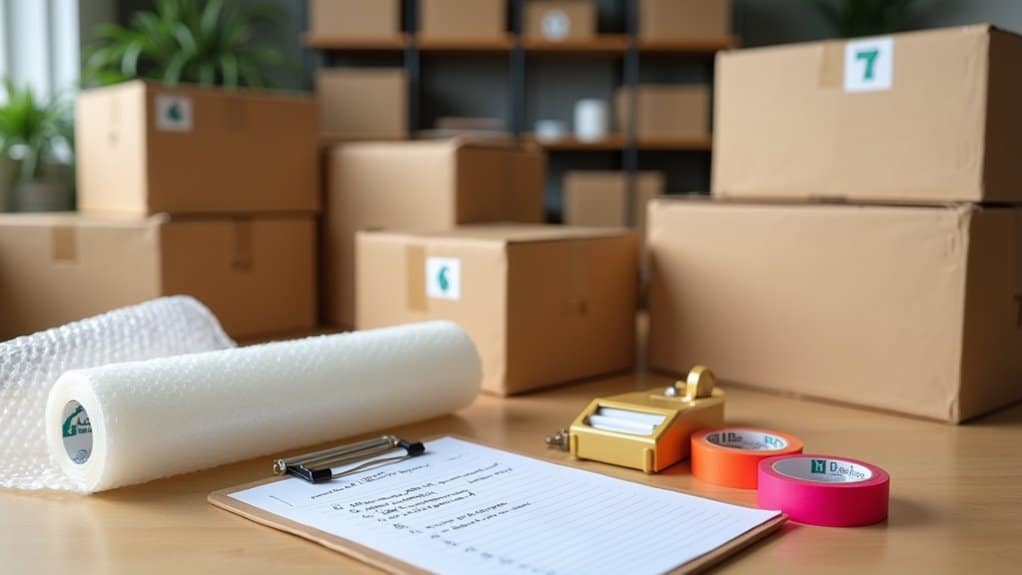
Packing Tips for Domestic Moves: Save Time and Money
To save time and money during your domestic move, start by decluttering each room. Tackle one room at a time and clearly label boxes with their contents and intended rooms. Use space-saving methods like packing clothes in suitcases and employing vacuum-seal bags for soft items. Protect fragile items by wrapping them individually and using sturdy boxes. Create a packing timeline to manage tasks effectively, beginning with non-essentials weeks in advance. Keep an inventory list to track your items and prevent losses. By following these strategies, you'll discover more tips to make your move smoother.
Key Takeaways
- Declutter before you start packing to cut down on the number of items, which can save you time and money on boxes and transport.
- Use suitcases and bags for your clothes to pack efficiently and reduce the need for additional boxes.
- Clearly label each box with its room and contents to make unpacking easier and avoid any confusion in your new home.
- Try space-saving methods like vacuum-seal bags for soft items to make the most of your packing space and minimise moving costs.
- Establish a packing timeline to keep yourself organised and on track during the move.
Effective Packing Strategies
When it comes to effective packing strategies, tackling one room at a time significantly boosts your efficiency. This focused approach helps keep things organised and prevents you from feeling overwhelmed.
Start by decluttering each room to minimise the number of items you need to pack. Once you've streamlined your belongings, sort them by room to make unpacking easier. It's also beneficial to create an inventory sheet to keep track of your packed items.
Clearly label each box with its contents and the destination room to ensure nothing goes missing during the move. When packing, place heavier items in smaller boxes to avoid them becoming too cumbersome. Leave some space at the top of each box for cushioning, and wrap fragile items in bubble wrap or packing paper for added protection.
To maximise organisation, pack similar items together and consider using suitcases for clothes and soft items, which can save on box space. Additionally, remember to utilize a packing calculator to determine your supply needs and gather materials in advance to enhance your packing efficiency.
Don't forget to prepare a "first night" box with essentials you'll need immediately upon arrival. Lastly, pack frequently used items last, so they remain easily accessible.
Space-Saving Techniques
Maximising space during your move can significantly improve efficiency. By using effective space-saving techniques, you can streamline your packing process and make the most of your materials.
Here are three practical strategies to consider:
- Nesting Boxes: Place smaller boxes inside larger ones to make full use of space. This keeps items organised and reduces the overall volume. Packing with a clear labeling system can further enhance your efficiency throughout the process.
- Utilising Suitcases: Pack clothes and textiles into suitcases or duffle bags. They serve as handy storage solutions and save space in the moving vehicle. Additionally, packing suitcases can also help you keep track of your essential items for easy access.
- Compression Methods: Use vacuum-seal bags or packing cubes for soft items like blankets and clothing. These methods reduce their volume significantly, freeing up room for other essentials. Additionally, consider using larger appliances to store smaller kitchen items to maximise available space.
This strategic packing keeps your items secure and simplifies unpacking. Remember, effective packing leads to a smoother moving experience, so take the time to implement these techniques!
Safeguarding Fragile Items
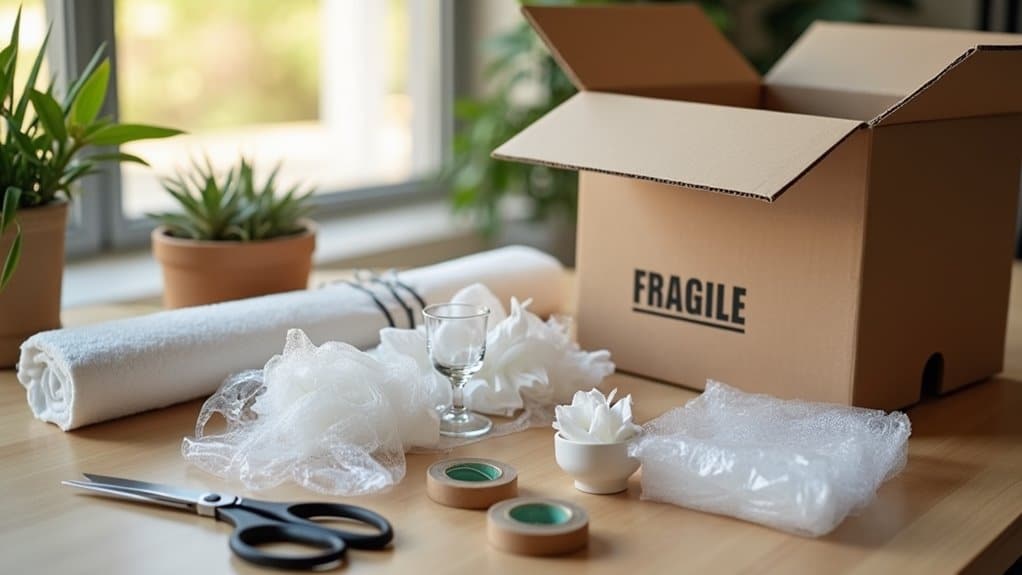
When packing fragile items, it's vital to use proper wrapping techniques to avoid breakage. Individually wrap each piece in bubble wrap or packing paper for cushioning and security. For added protection during your move, consider using specialised packaging solutions like dish packs for crockery or custom boxes for artwork. Additionally, using dividers and padding can help prevent shifting during transport, further safeguarding your belongings. It's also essential to be aware of fragile items that may require special attention to ensure they are securely handled throughout the moving process.
Proper Wrapping Techniques
Safeguarding fragile items during a move is essential to avoid breakage and damage. Using proper wrapping techniques ensures your delicate belongings arrive safely at your new home.
Here are three effective strategies:
- Layer Up: Wrap each fragile item in several layers of bubble wrap or packing paper. This provides cushioning to absorb shocks.
- Cover All Angles: Ensure every corner and odd angle of the item is covered. This helps prevent chipping or cracking during transit.
- Secure Your Wrap: Use packing tape to fasten the wrapping tightly. This minimizes movement of the cushioning materials inside, ensuring nothing shifts during transport. Additionally, using professional movers can greatly reduce the risk of damage during the moving process.
Consider using soft materials like towels or old rags for extra padding.
When packing fragile items in boxes, layer the bottom with soft packing material and fill any gaps with additional cushioning.
Specialized Packaging Solutions
Using specialised packaging solutions can significantly protect your fragile items during a move. Custom crate designs tailored to your needs ensure delicate items, such as artwork and electronics, are securely transported, reducing the risk of damage. In addition, working with a trusted partner for third-party relocation services can further enhance the safety of your belongings during transit.
When packing fragile items, choose the right packaging materials. Sturdy boxes specifically designed for items like mirrors and mattresses provide extra protection.
Individually wrapping items in bubble wrap or foam sheets adds cushioning, while cardboard dividers and packing peanuts help prevent shifting in transit.
If you're uncertain about packing delicate items, consider on-site packing services. Professional teams can expertly handle and package your fragile belongings, giving you peace of mind.
Additionally, clearly label each box with its contents and handling instructions to ensure movers treat your items with care.
Don't overlook corner protectors for frames and other delicate parts. By using these specialised packaging solutions, you'll safeguard your fragile items and make your move more efficient.
Must-Have Essentials
Moving can be daunting, but having the right essentials makes it much easier. To stay organised and streamline the process, create a packing checklist with these must-have items:
1. Immediate Living Essentials: Air mattresses or sleeping bags are crucial for comfort until your main beds arrive.
Don't forget bath towels and toilet paper to keep things hygienic in both properties.
2. Basic Household Supplies: Hand soap and laundry detergent are essential for cleanliness and immediate laundry needs.
Stock up on rubbish bags and basic cleaning supplies to manage waste and keep your new home tidy.
3. Packing Essentials: Ensure you have packing boxes in various sizes, packing tape for securing everything, and bubble wrap for fragile items.
Markers are handy for labelling boxes, so you can easily find what you need later.
Decluttering Before Moving
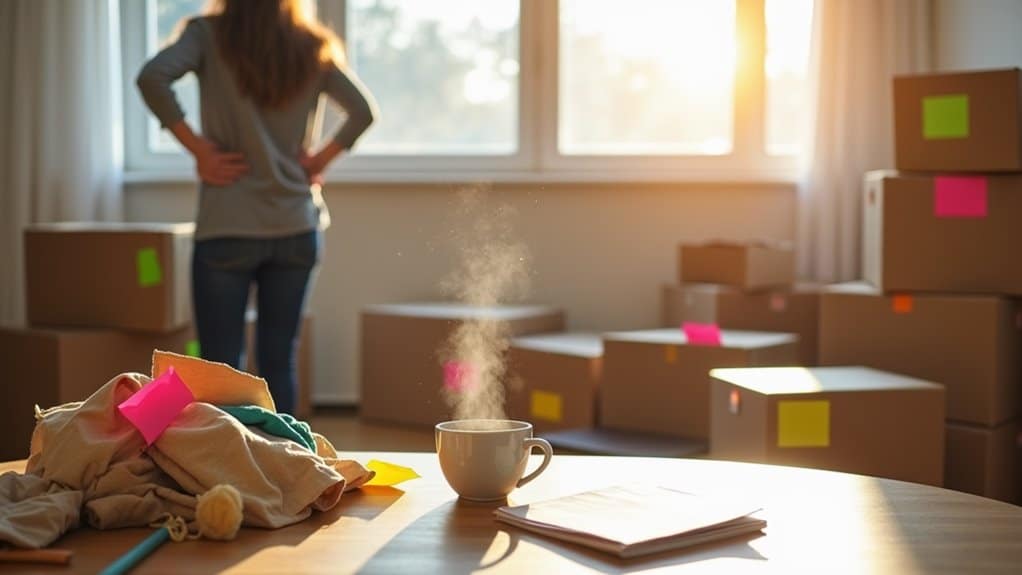
Decluttering before a move is crucial for a smoother transition into your new home. Ideally, start this process 6-12 months in advance to minimise stress and simplify everything.
Create a decluttering timeline to organise tasks, such as ordering moving supplies and sorting your belongings.
Tackle one room at a time. Set clear goals for what you want to achieve, as decluttering can save you time, money, and effort during the move. Involve family members to make the process more efficient and less daunting.
Begin by disposing of unwanted items, especially those that are expired or broken. Use a "maybe" pile for items you're uncertain about. Start with cluttered areas like garages or attics.
Visualising your new space can help you decide what to keep. Consider donating usable food and items in good condition to local charities, or organise a car boot sale.
Efficient Time Management
After sorting your belongings, it's essential to manage your time effectively during the packing process. Good time management is crucial for a smooth move, so let's break it down into straightforward steps.
1. Create a Moving Timeline**: Set clear deadlines** for each task and use a calendar to keep track.
Start packing non-essential items 4-6 weeks before your moving date to avoid any last-minute panic.
2. Prioritise Your Tasks: Focus on high-priority tasks, such as booking removal services and transferring utilities, first.
This ensures that you address the most important aspects of your move without delay.
3. Allocate Your Time Wisely: Divide your packing into smaller, manageable tasks.
This strategy makes the process less daunting and allows for better time management throughout the packing period.
Organizing Your Packing Schedule
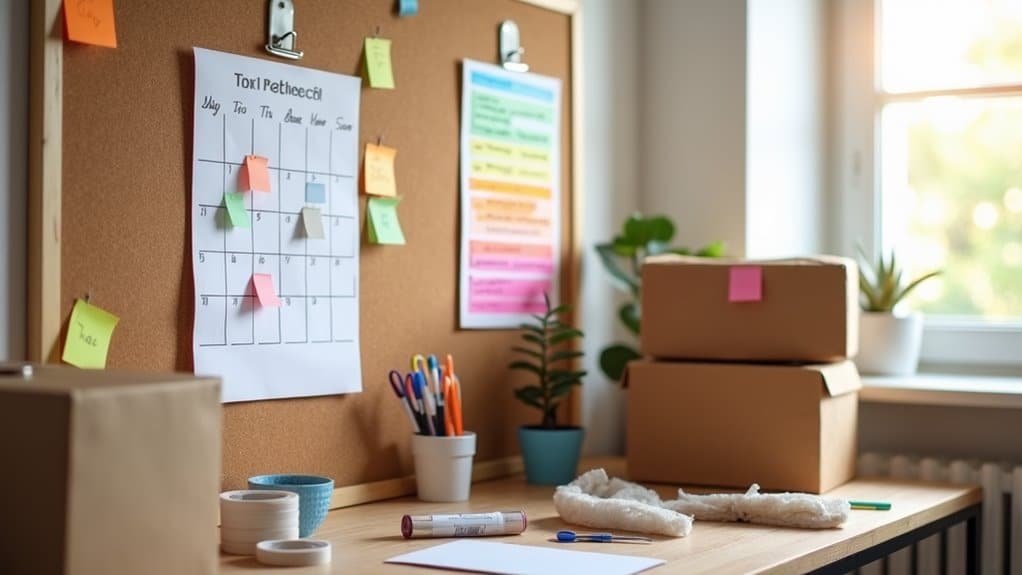
Organising your packing schedule can greatly improve the smoothness of your move. Start by creating a packing checklist that details tasks for each week leading up to moving day. Aim to start packing 5 to 7 weeks in advance to gather essential supplies like boxes and tape.
Four to six weeks before your move, focus on decluttering. Go through your belongings and sell or donate items you no longer need.
By the third week, begin packing rarely used items, such as holiday decorations and off-season clothing.
As you approach the two-week mark, pack up your kitchenware and essentials, ensuring you label boxes clearly for easier unpacking.
In the final week, finish packing any remaining items, double-checking that all boxes are clearly labelled.
Throughout this process, prioritise packing "Open Me First" boxes with immediate necessities. Keep valuable items and important documents separate for safe transport.
Utilizing Packing Supplies
When preparing for your move, choosing the right packing supplies is crucial to ensure everything arrives safely at your new home. Making smart decisions about your packing materials can also save you time and money. Here are some key items to consider:
- Sturdy Boxes: Opt for strong, purpose-built boxes for heavy or fragile items to ensure they hold up during the move.
- Wrapping Paper: Use ink-free paper to wrap delicate items, providing cushioning to prevent breakage.
- Bubble Wrap: Perfect for fragile items like glass or ceramics, bubble wrap adds an extra layer of protection during transit.
Don't overlook eco-friendly options! Many sustainable packing materials, such as recycled boxes and biodegradable packing peanuts, are available.
Also, reusing items like suitcases and baskets can significantly cut down on waste and costs.
Investing in quality packing tape, cling film, and furniture protectors will also help safeguard your belongings.
Labeling for Easy Unpacking
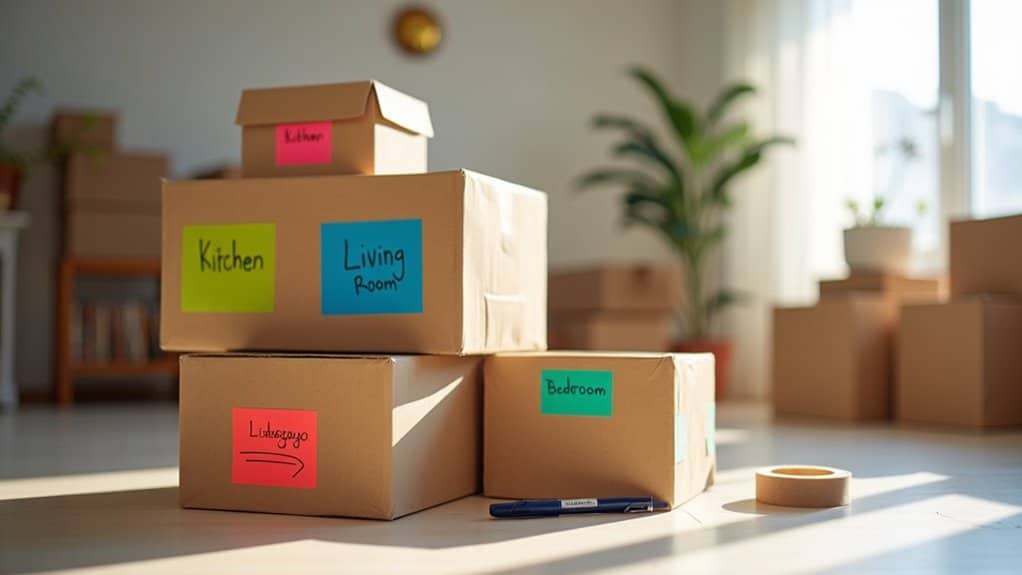
When it comes to unpacking efficiently, a good labelling system is essential.
Consider using a colour-coding system to quickly identify which boxes belong in each room, alongside clear labels that detail their contents and any handling instructions. For example, you might use blue for the kitchen and green for the bedroom.
Keeping an inventory list will also help you track your belongings and ensure nothing goes missing during the move.
Color-Coding System
Using a colour-coding system can significantly simplify your unpacking process during a move. By applying colour psychology, you can create a visual organisation that minimises confusion and boosts efficiency.
Assigning specific colours to each room enables you and your movers to quickly identify where each box should go, saving you time.
Here are three straightforward steps to implement your colour-coding system:
- Choose Distinct Colours: Opt for bold colours like red for the kitchen, blue for the living room, and green for bedrooms. This allows for quick identification.
- Create a Colour Key: Make a simple chart that lists which colours correspond to each room. Distribute copies and display them prominently in your new home.
- Use Clear Labels: Mark boxes with coloured tape or stickers that are large and visible. This encourages systematic unpacking, making the entire process less stressful.
Clear Labeling Techniques
Clear labelling techniques are essential for a smooth unpacking experience after your move. By using a consistent labelling system across all boxes, you'll reap significant benefits.
Start by adding clear labels that specify the contents, the room they belong to, and any handling instructions. Position these labels on visible areas, like the sides and tops of boxes, using bold, legible text or distinctive stickers.
For items you'll need immediately, mark priority boxes with unique labels—consider using specific colours, large text, or symbols. Designate one or more boxes as "Essentials" to ensure important items are easily accessible.
When packing fragile items or electronics, use colour-coded labels to match cables and devices, and clearly indicate handling instructions.
To make the labelling process efficient, start early and consider using waterproof materials. Double-check the labels before moving day to ensure they're accurate, and use visual cues, such as stars for priority boxes.
Inventory Management Tips
To ensure a smooth unpacking experience, effective inventory management is essential during your move. Begin early by creating an inventory checklist to avoid overlooking any items.
Sort your belongings by room and category to simplify tracking during both packing and unpacking.
Here are three practical tips to improve your inventory management:
- Label Each Box: Clearly label each box with its contents and assign a unique box number. This allows for quick identification without the need to open every box.
- Document Item Condition: As you pack, record the condition and value of each item. This is important for insurance and helps you keep track of any damage that may occur during the move.
- Use Digital Tools: Consider employing digital apps or spreadsheets for your inventory. They make tracking items easier and allow for on-the-go updates to your checklist.
Seeking Assistance When Needed
When facing the challenges of a domestic move, it's wise to consider seeking help if you're feeling overwhelmed. There are various local resources and financial assistance programmes available to help ease the transition.
Start by looking into options like the Move.org moving grant, which provides a one-off relocation package of £500 for those planning to move within six months. If you're a veteran, the Veterans Affairs Housing Assistance can offer substantial support.
For individuals in low-income situations, organisations such as the YWCA and Catholic Charities provide emergency moving assistance tailored to your needs.
Don't forget about the Community Services Block Grant (CSBG), which funds local agencies to assist low-income families with moving costs. Additionally, calling 211 connects you to a range of community services, ensuring you access any available support.
Be sure to check the eligibility requirements, as many programmes need proof of income and may vary by region. Applying promptly is crucial since response times can differ significantly.
Seeking help not only reduces stress but can also save you time and money during your move. Don't hesitate to reach out for the support you need!
Frequently Asked Questions
How Do I Choose the Right Moving Company?
To select the right moving company, start by reading reviews from previous customers. Compare their insurance options and ensure they have the necessary licensing. It's also wise to ask friends or family for recommendations. Make sure the company can cater to your specific needs for a hassle-free move. For example, if you have fragile items, check if they offer specialised packing services.
What Should I Do With Unwanted Items?
When handling unwanted items, think about donating usable goods to local charities or organisations. You can also sell items online through platforms like eBay or Facebook Marketplace, or hold a garage sale. These options not only help clear your space but also support others and can even earn you a bit of extra cash.
How Can I Keep My Pets Calm During the Move?
To help keep your pets calm during the move, use calming techniques such as familiar toys and pheromone sprays. Ensure you have essential items ready, including food, water, and a quiet space for them on moving day. Consider using a comfortable crate or a favourite blanket to create a sense of security.
What Are the Best Ways to Protect My Furniture?
To protect your furniture, use furniture padding and secure coverings, such as blankets or bubble wrap. Disassemble larger items, label each part, and make arrangements for delicate pieces to ensure they arrive safely at your new home.
How Do I Handle Moving During Extreme Weather?
When moving during extreme weather, it's crucial to prioritise preparations. Keep an eye on weather forecasts and use waterproof covers for your belongings. Ensure safety by clearing pathways, dressing appropriately for the conditions, and having an emergency kit on hand for any unexpected issues. For instance, if you're moving in heavy rain, consider using tarps to protect your furniture and boxes.
Conclusion
By following these packing tips, you can simplify your domestic move, saving both time and money. It may seem daunting at first, but breaking it down into smaller tasks makes it much more manageable. Start early, utilise space-saving methods, and don't hesitate to ask friends or family for assistance. With a clear plan, you'll discover that packing can be straightforward and less stressful. Embrace the process, and you'll ensure your move is smooth and efficient.


